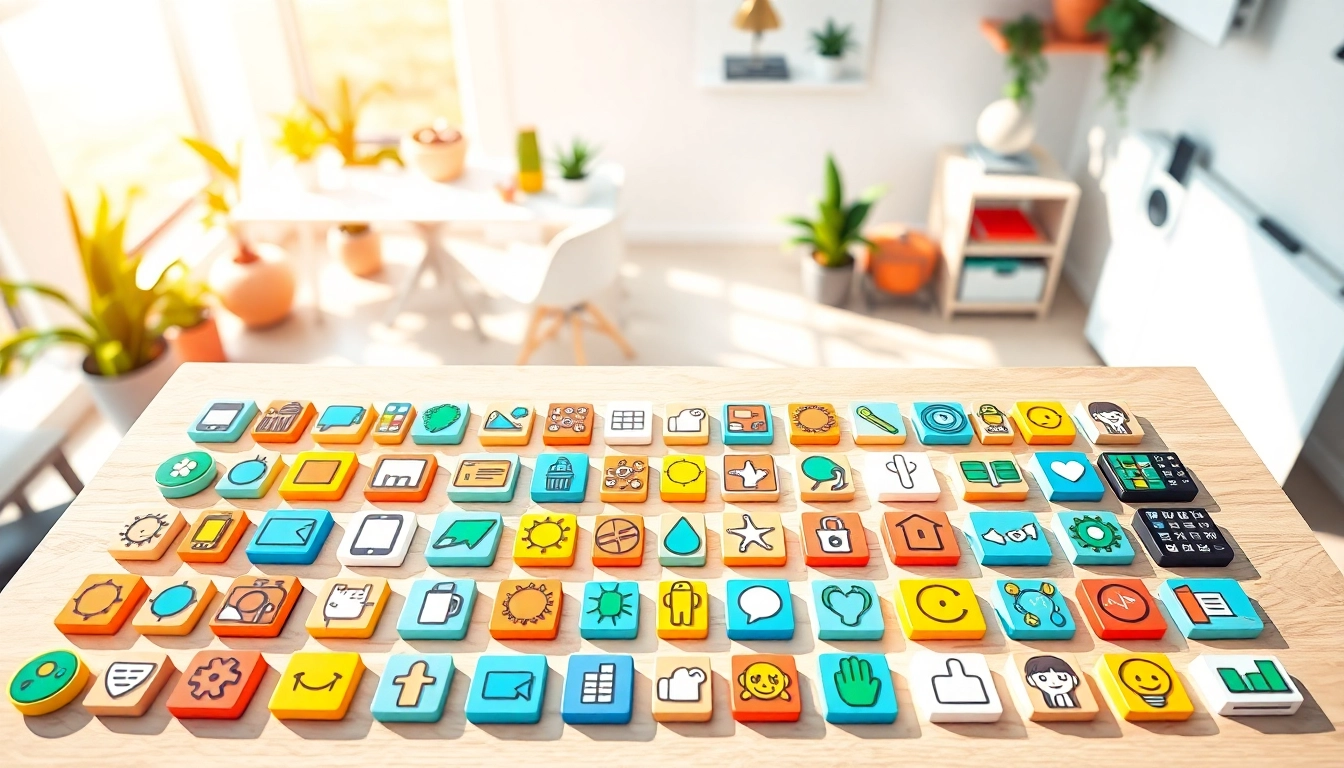Understanding Icons and Their Significance
In today’s digital landscape, icons are not just mere decorative elements; they represent a critical component of user interface design and communication. Icons communicate ideas quickly and effectively, serving as visual shortcuts that help users navigate complex systems with ease. In this section, we will explore the definition of icons, their role in communication, and the historical evolution that has shaped their use in modern design.
What are Icons?
Icons are simplified graphic representations used to depict an object, action, or concept in visual form. They can range from simple symbols, such as a magnifying glass representing search functionality, to complex illustrations that convey emotional and contextual meanings. Icons play a vital role in providing a visual language that transcends linguistic barriers, enabling global communication.
The Role of Icons in Communication
Icons serve as critical tools for facilitating communication, especially in an increasingly digital world where visual elements often convey messages more effectively than text. They allow for quicker comprehension and can enhance user experience by guiding users intuitively through applications and websites. For example, icons for home, search, and settings are universally recognized and eliminate the need for text explanations, thereby improving usability.
History and Evolution of Icons
The use of icons has a rich history, dating back to ancient civilizations where symbols represented various aspects of life, culture, and spirituality. Over time, their use evolved dramatically, particularly with the advent of technology. In the latter half of the 20th century, the rise of personal computing paved the way for digital icons, designed to enhance navigability and usability of software applications. This evolution continued with the development of the internet, leading to the modern icons that we see today, characterized by minimalist designs and clarity in representation.
Types of Icons in Various Mediums
Icons can be found across multiple mediums, each serving distinct purposes in graphic design, web interfaces, and marketing. Understanding the different types of icons is crucial for designers aiming to utilize them effectively in various contexts.
Graphic Design Icons
In graphic design, icons often represent actions or objects in a visual language that aligns with the overall aesthetic of a project. Graphic design icons are used in print materials, branding, and digital spaces to convey messages succinctly. They are essential in logo design, infographics, and promotional materials. Successful design often incorporates a consistent style, ensuring that all icons reflect the brand’s identity.
Interface and Web Icons
Interface icons are designed for digital environments, particularly within software applications and websites. These icons help users navigate interfaces and perform functions efficiently. Examples include buttons, menus, and status indicators that enhance the usability and functionality of web applications. With the rise of responsive design, interface icons must now be adaptable to different screen sizes and devices, highlighting the importance of scalable vector graphics (SVG) for preserving quality across resolutions.
Marketing and Branding Icons
In marketing, icons are used to reinforce brand identity and enhance messaging. They contribute to building the brand narrative through familiar visual elements that evoke emotions and recognition. For example, using a specific icon consistently across marketing materials not only strengthens brand recall but also helps communicate core values and service offerings effectively. Icons used in infographics can help break down complex information, making it more digestible for audiences.
Designing Effective Icons
Creating effective icons requires a deep understanding of design principles and a strategic approach. This section will explore best practices for icon design, the tools available for designers, and common pitfalls to avoid.
Best Practices for Icon Design
Effective icon design hinges on several best practices:
- Clarity: Icons should be easily recognizable and convey their intended meaning at a glance. Avoid overly complex designs.
- Consistency: Ensure a uniform style across all icons within a project. This includes color palette, line weight, and level of detail.
- Scalability: Icons must be designed as scalable vector graphics to maintain their quality across various sizes.
- Context: Consider the context in which your icons will be used. This includes understanding the target audience and the platform.
Tools and Software for Icon Creation
Several tools and software options are available for icon design. Some popular choices include:
- Adobe Illustrator: Ideal for creating vector icons with advanced design features.
- Sketch: A favorite among web designers for its intuitive interface and collaboration features.
- Figma: A web-based tool that allows for real-time collaboration in icon and UI design.
- Inkscape: A free, open-source alternative for creating vector graphic icons.
Common Mistakes to Avoid
Designers should be mindful of common mistakes when creating icons, including:
- Overcomplication: Incorporating too much detail can lead to confusion; icons should be simplified.
- Neglecting User Experience: Icons should be designed with usability in mind, focusing on what users find intuitive.
- Ignoring Accessibility: Ensure icons are distinguishable for those with visual impairments by considering color contrast and iconography.
- Inconsistency: Using varying styles can confuse users; maintain a cohesive design language.
Trends Driving Icon Usage Today
The design landscape is constantly evolving, and so is the use of icons. This section discusses current trends that are shaping icon usage in modern design.
Minimalistic vs. Detailed Icons
The preference for minimalistic icons has surged in recent years, emphasizing simplicity and clarity. However, detailed icons are also making a comeback in certain contexts, such as storytelling and branding. Designers need to strike a balance between these two approaches based on project goals, target audience, and the overall aesthetic.
Simplified Shapes and Flat Design
Flat design has become a dominant trend in the design world, moving away from intricate details and three-dimensional effects. Simplified shapes contribute to cleaner designs that load faster and are easier to recognize. The adoption of flat icons also promotes a cohesive digital experience across platforms, enhancing usability.
The Rise of Animated Icons
Animation adds a dynamic quality to icons, capturing users’ attention and enhancing engagement. Animated icons can illustrate actions or transitions, enriching the user experience. Utilized effectively, they can reinforce functionality and provide visual feedback, such as showing an action has been completed or an element has been selected.
Implementing Icons in Your Projects
Successfully integrating icons into projects requires careful consideration of several factors. This section will explore how to select and implement the right icons and measure their impact on user engagement.
Selecting the Right Icons for Your Brand
Choosing the right icons is crucial for aligning with your brand identity. Pay attention to:
- Brand Message: Icons should resonate with your brand’s core values and messaging.
- Target Audience: Consider the preferences and cultural perceptions of your target audience when selecting icons.
- Consistency with Other Design Elements: Ensure that your icon style harmonizes with the overall design language of your project.
Integrating Icons into User Interfaces
In user interfaces, placement and functionality are critical. Icons should be integrated to enhance user experience:
- Clarity of Purpose: Ensure that users can quickly understand what each icon represents.
- Strategic Placement: Place icons where users expect to find them, such as a home icon in the top left corner and a menu icon in the top right.
- Interactive States: Icons should visually indicate different states, such as hover effects or active states to provide user feedback.
Measuring the Impact of Icons on Engagement
To assess how icons affect user engagement, it’s essential to employ metrics such as:
- Click-Through Rates (CTR): Analyze how different icons influence users’ action rates.
- User Feedback: Gather qualitative feedback from users regarding icon design and usability.
- A/B Testing: Test different icon styles or placements to determine which options yield better engagement outcomes.
In conclusion, icons are integral to effective communication in digital design, providing users with visual cues that enhance usability and navigation. By understanding the various types of icons, implementing best practices in design, and staying updated on trends, designers can create impactful projects that resonate with users and drive engagement.


